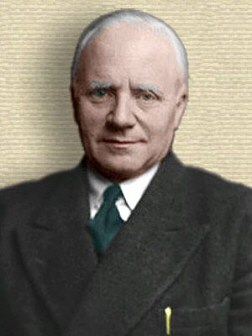Gavin de Beer facts for kids
Quick facts for kids
Sir Gavin de Beer
|
|
|---|---|
 |
|
| Born |
Gavin Rylands de Beer
1 November 1899 Malden, Surrey, England
|
| Died | 21 June 1972 (aged 72) |
| Nationality | British |
| Known for | Heterochrony |
| Awards | Linnean Medal (1958) Kalinga Prize (1968) Darwin Medal Fellow of the Royal Society |
| Scientific career | |
| Fields | embryologist |
| Institutions | British Museum (Natural History) |
Sir Gavin Rylands de Beer (born November 1, 1899 – died June 21, 1972) was a British scientist who studied how living things develop from embryos. He was especially known for his ideas about how changes in development can lead to evolution. He wrote a famous book in 1930 called Embryos and Ancestors. Sir Gavin also led the important Natural History Museum in London. He won the Darwin Medal for his work on evolution.
Contents
About Gavin de Beer
Gavin de Beer was born in Malden, England, on November 1, 1899. He spent much of his childhood in France and also loved visiting Switzerland. He went to school at Harrow and then studied zoology (the study of animals) at Oxford University. He paused his studies to serve in the First World War.
After graduating in 1921, he started teaching zoology at Oxford. In 1938, he became a professor who specialized in embryology at University College London.
During the Second World War, he served in the army again. He worked in areas like intelligence and helping with public information. In 1940, he was chosen to be a Fellow of the Royal Society, which is a very high honor for scientists.
In 1945, de Beer became a full professor of zoology. From 1950 to 1960, he was the director of the British Museum (Natural History). In 1954, he was made a knight, which means he received the title "Sir." He also received the Darwin Medal in 1957 for his important studies on evolution.
After he retired in 1960, Sir Gavin moved back to Switzerland. He wrote several books about Charles Darwin, the famous scientist who developed the theory of evolution. He also wrote about Switzerland and the Alps. Sir Gavin de Beer returned to England in 1971 and passed away on June 21, 1972.
Sir Gavin's Scientific Work
Sir Gavin de Beer's early work at Oxford focused on experimental embryology. This is the study of how living things grow and develop from their earliest stages. He worked with other important scientists like Julian Huxley. Together, they wrote a book called Elements of Experimental Embryology in 1934, which was a key summary of the field.
Understanding Evolution Through Development
In his 1930 book Embryos and Ancestors, de Beer highlighted the importance of something called heterochrony. This is when the timing of development changes during evolution. He was especially interested in paedomorphosis, which means that an adult animal keeps some features that were only seen in its younger, juvenile form.
De Beer believed that paedomorphosis was more important for evolution than the opposite (when adult features become more pronounced). This is because young tissues are more flexible and can change more easily. Older, specialized tissues are less likely to change.
Clandestine Evolution
Sir Gavin also came up with the idea of clandestine evolution. This helped explain why the fossil record sometimes shows sudden changes in species, even though Charles Darwin's theory suggested evolution happens slowly.
De Beer thought that if new features developed gradually in an animal's young form, they might not show up in fossils at all. But if the species then underwent neoteny (a type of paedomorphosis where an animal becomes able to reproduce while still looking like a juvenile), the new feature would suddenly appear in the fossil record. This would happen even though it had been evolving slowly for a long time.
Other Contributions
Sir Gavin de Beer also studied ancient birds (paleornithology) and general ideas about evolution. He helped explain the idea of mosaic evolution, where different parts of an animal evolve at different rates. He showed this with his review of Archaeopteryx, a famous fossil that looks like a mix of a dinosaur and a bird.
He was also dedicated to making science easy for everyone to understand. For this, he received the Kalinga Prize from UNESCO.
Hannibal's Alps Crossing
Interestingly, de Beer was the first to suggest that the Col de la Traversette pass was the most likely place where the ancient general Hannibal crossed the Alps with his elephants. Later research in 2016 found evidence at the pass that supported his idea, showing that the ground had been disturbed by many animals and people around the time of Hannibal's invasion.
See also
 In Spanish: Gavin de Beer para niños
In Spanish: Gavin de Beer para niños

